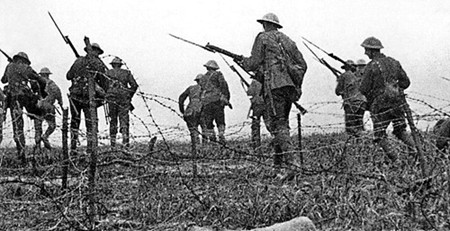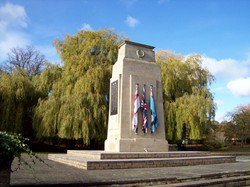|
The
Somme remembered and the Bourne The centenary of the Somme is being observed this summer (2016), one of the bloodiest and most horrific battles of the First World War of 1914-16 and in human history. It was fought by the armies of the British and French empires against the German Empire and took place between July 1st and 18th November, 1916, on both sides of the River Somme in France when more than one million men were wounded or killed. Much has been written about this now legendary conflict but it is the words of the men who were there that we remember and as most soldiers wrote home regularly to their loved ones, an impressive archive of letters survives from soldiers who took part, including some from those who lived in Bourne. Many of the soldiers sent to the front had been pupils at the Boys' Council or Board School in Star Lane [now the Abbey Church of England Academy in Abbey Road] and before leaving for overseas they had been persuaded by their old headmaster, Joseph J Davies, to keep in touch by letter and he replied to each one. Private John Bannister, whose mother lived in Woodview, Bourne, was serving with the Lincolnshire Regiment but had been wounded in the battle and he wrote from a convalescent camp at Boulogne: “I have been reported missing because I was buried for about four hours. They thought I was blown up. But I wasn't. All the boys are confident that the war will be over very soon.” Sergeant Cedric Lloyd of the Royal Fusiliers wrote to his mother from a military hospital somewhere in France after being wounded on September 18th. Cedric described some successful attacking operations in which he and his comrades took part and referred to the effectiveness of tanks that had been used for the first time but was at pains to say that he was recovering from his injuries: “I am pleased to tell you that my knee is getting on very well. The wounds just above the knee have practically healed and I am now allowed to get up for a few hours a day.” Private Martin Barnes, of Willoughby Road, Bourne, who was serving with the Sherwood Foresters, was wounded in the battle and was recovering in hospital somewhere in France from where he wrote to Mr Davies about the quiet courage of his comrades: “Every man who has been engaged on the Somme front has earned a name for himself that ought never to be forgotten. We were engaged in the fighting at Trones Wood [behind the German lines] and to lose that wood was one of our greatest setbacks for it changed hands no fewer than four times before the 21st Division took it. We were their reserves. It took six and a half hours to drive the Germans out. The Northamptons and West Kents at last succeeded in but not until those battalions had lost nearly all their men. We relieved them. I am proud to say we even took the enemy trenches in front of us but the roll call proved how heavily we had paid for it.”
All three survived the Somme but seven soldiers from Bourne did not and their names are listed on the cenotaph in the War Memorial Gardens in South Street and the Thiepval Memorial at Picardy in France. They were Private George Sherwin and Lance Corporal Ralph Pattison (Lincolnshire Regiment), Private Frederick Smith (the London Regiment), Private Harry Pearce (Royal Fusiliers), Privates William Lunn and James Smith (Royal Lancaster Regiment) and Private Arthur Lane (South Lancashire Regiment). The public was largely unaware of what had been happening at the front until a dramatic film entitled The Battle of the Somme which had been filmed on location during the conflict was given several public showings by the Bourne Electric Theatre Company during November and December 1916 when the Corn Exchange was packed on each occasion and additional seating installed to cope with the crowds. The 77-minute official film had been released on 21st August 1916 and watched by 20 million people in the country during the first six weeks. Lloyd George, then Secretary of State for War but had become become Prime Minister later in the year, said: “If the exhibition of this picture all over the world does not end war, God help civilisation!” An idea of the impact the film made was given in a review by the London Evening News which said: " "The Battle of the Somme is the greatest moving picture in the world – the greatest that has ever been produced. A great war picture, it is the finest peace picture the world has ever seen; it is worth a thousand Hague conferences. Wherever it is shown it should make an end in the minds of men to the pretensions of pompous prices who have too long claimed the right as the “All Highest” to doom their fellow creatures to suffering and destruction for the gratification of their mad ambitions. It is impossible to believe that the world will ever forget this picture: its impression will never fade from the memory of this generation. Men who see it will never lightly talk of war again. In this picture the world will obtain some idea of what it costs in human suffering to put down the devil’s domination.” In Bourne, there was so much interest that some parents kept their children away from school to see it. Records from the infants' school in Abbey Road note that on 30th November 1916 the attendance marks of two sisters were cancelled "because their mother fetched them away from school at 2.30 pm to see the Somme film." The flickering silent images on the screen were the first pictures to be seen in Bourne of the war, certainly of the mud and blood of the Somme, and the audience was stunned into total silence and many were moved to tears. The response was the immediate formation of a fund to buy Christmas parcels for the Bourne soldiers, the proceeds from the two screenings being the first contribution followed by a flag day in the town which produced further funds and a house-to-house collection that pushed the figure up to £102 [over £8,000 at today's values]. Two hundred parcels containing food, sweets and tobacco were eventually dispatched to local serving soldiers at the front while postal orders were sent to 30 soldiers who were wounded and recovering at hospitals in both Britain and France because they were not receiving any money while patients. There were also four Bourne soldiers who were prisoners of war and cash gifts for each sent to the Central Relief Committee in London to pay for parcels to be forwarded to all of them for a period of four weeks. This was the first indication of how many men from Bourne were serving with the armed forces, a total of 234 from a population at that time of 4,310 [the 1921 census figure]. The Great War, as it subsequently became known, lasted from 1914-18 and resulted in over 38 million military and civilian casualties with over 17 million deaths and 20 million wounded, ranking it among the deadliest conflicts in human history. When it was over, war memorials were built in towns and villages across the country to honour the dead and here in Bourne our own cenotaph in South Street which was opened in 1956 remembers the 134 men who made the supreme sacrifice. Bourne is therefore keeping faith with all of those who gave their lives in battle in accordance with Binyon’s evocative words that have become an integral part of Remembrance Sunday: “At the going down of the sun and in the morning, We will remember them.” NOTE: I am indebted to military historian Tony Stubbs for his help in identifying the Somme victims from Bourne and for his photograph of the Thiepval memorial. WRITTEN JUNE 2016
Go to: Main Index Villages Index |

